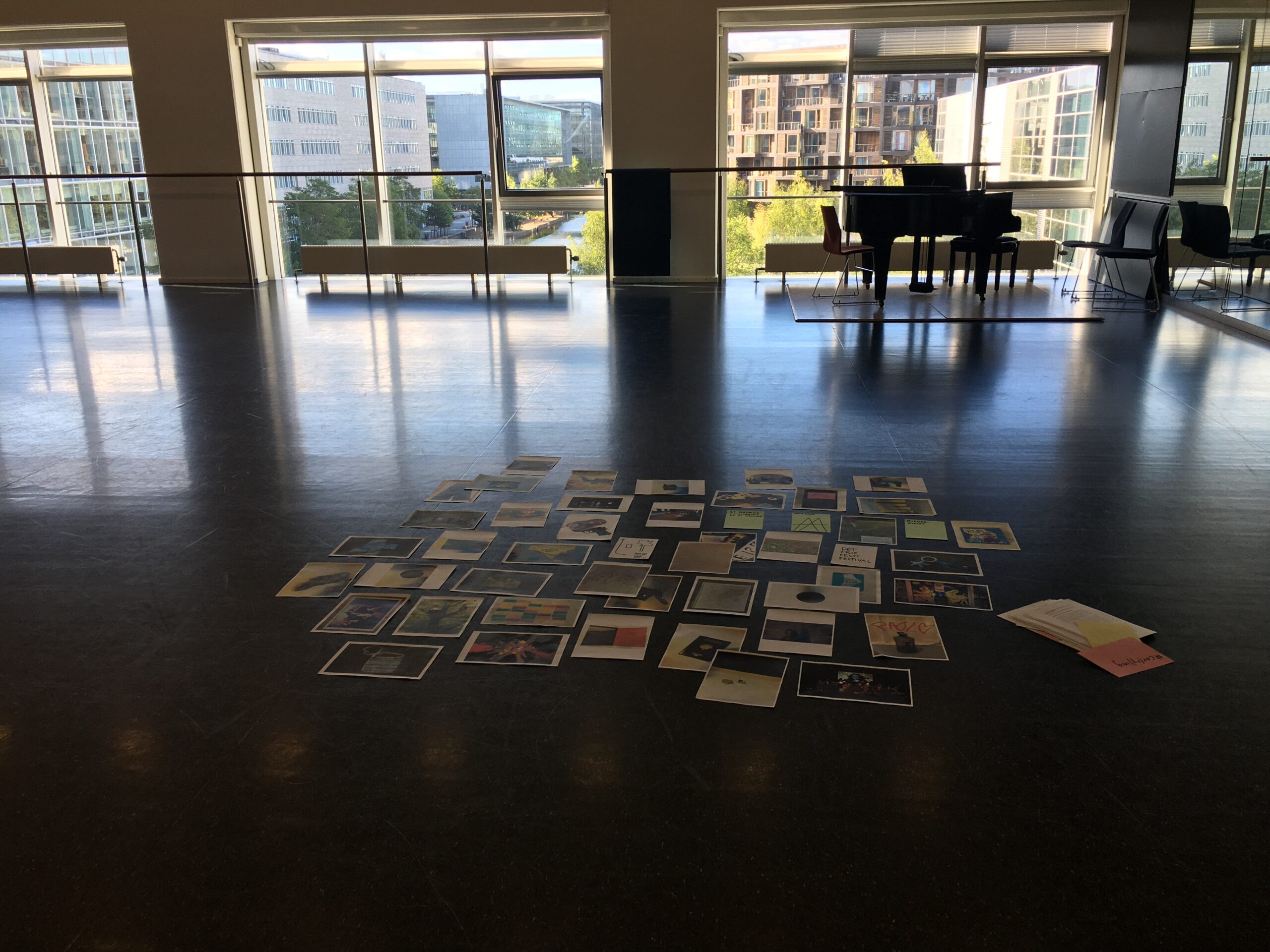For three-plus weeks, the initiative Danish Dance Stories (represented by me), was invited by the performing arts organization HAUT and Karen Vedel/IKK – Department of Arts and Cultural Studies at Copenhagen University, to reside in a beautiful dance studio at Copenhagen University South Campus through HAUT’s pilot project for artistic research named ”IN DEPTH”. As the heat wave outside the studio recurrently brought me onto memory lane back to personal dance stories at residencies in New York or Istanbul – I was simultaneously daydreaming and worrying about individual and collective futures. My present task was however to stay with the rare and precious opportunity to dwell, dialogue and care for what Danish Dance Stories has produced so far. As a method to discover unarticulated knowledges and as lasting documentation of this research in residence, I decided to work within the creation of a text – this essay.
Danish Dance Stories (Danske Dansehistorier) is an artistic initiative by me, Andrea Deres, Stine Frandsen and Nanna Stigsdatter, four freelance dancers and choreographers, mainly based in Copenhagen. So far the initiative has been manifested through four weekend-symposiums in 2018 and 2021, as well as a week-long residency in 2018. Beyond those encounters, we have created a webpage, danskedansehistorier.dk, where stories stemming from the different events are documented.
Setting frames
In the planning phase of the residency, together with Andrea, the two of us decided that I would focus the research on the webpage. I would (re)visit the collected materials, also referred to as stories; a considerable amount of documents in sound, image and text. We were curious to explore the site through the lens of an archive and by testing out this label for the website, we hoped to learn more of how its content is constituted and perceived, how it matters and what it potentially could become.
In order to set me off, we formulated an initial focus, where I each of the three first days would look into the stories within a specific tag. The tagsare categorizations (like for example imaginations, limitations, stumbling and poetisk nerve), which developed as subtle or explicit topics during the encounters. Now they function as one of the proposed navigation tools at the site.
To bring in more perspectives and impressions and to shed light on some of the blindspots a project like this inevitably produces, we invited some people to visit me in the studio and give their feedback on the webpage. They are all engaged in the dance and arts field in different ways, but have not participated in any of the Danish Dance Stories events or activities earlier. I am deeply grateful for the conversations with Phyllis Akinyi, Teresa Fogh Schou, Mette Garfield and Lisa Nyberg, which all have enriched the process, as well as the future of this initiative, immensely.

Screenshot from ”Map” (https://danskedansehistorier.dk)
I also brought with me Donna Haraway’s scripture Staying with the Trouble – Making Kin in the Chtulucene (2016) . Humble about her planetarian undertaking, I cannot help finding her work inspiring in many sorts of artistic processes. I therefore hung out with her witty and brilliant formulations, allowing them to help me express and articulate thoughts and sensations which otherwise felt slippery and ungraspable.
Beginning to dig
I spent the first day of the residency with the stories within the tag #future dance, the second day with #car(ry)ing. I quite soon realized that if I was to revisit all content within the tags, it was impossible to keep up with the predicted pace. Before entering #hosting – which I had set out to be the third and final filter to dive into – I began to stumble. Where I am going with this? As interfering questions became too loud, I began to deviate, while (re)turning to the connotations and friction embedded in the title of the webpage as well as the project. Danske. Danse. Historier < Danish. Dance. Stories. What does this constellation of words propose and how have we as organizers been able to take care of the complexities implied in these potentially rigid matters? Which stories, who’s stories? Is the webpage a site of documentation, archiving or historisation; all of them or in between them? Does this matter? Who feels invited to this site and for what reasons? What inclusions and thereby exclusions does this initiative entail? In other words, what potentials, constraints and meanings would I be able to detect these coming weeks?
I am not a soloist, I like and need company in order to work well, so as I sat on the floor in the dance studio, surrounded by papers and notes, I began to look for ways of engaging with conversation partners. In one of the stories – the lecture The personal as/is historical, Paula Caspão introduces the concept of palimpsest, a document which becomes over-written with newer text or image. (Cecilie Ullerup Schmidt also applied this method in her lecture-workshop Our body moves beyond borders – on how Danish dance herstories are international and in concert. Inspired by this technique, I began to relate to the stories of the website – their embedded words, feelings, arguments and memories, as a foundation which could permeate, thread, disturb and maybe foremost accompany me in the writing process.

In the planning phase, writing an essay sounded quite liberating, maybe even potentially poetic. But as questions overwhelmed me and the sweat began to drip, I leaned on the translation of the term to regain direction: Essayer – to try, to attempt. As Danish Dance Stories is an attempt to meet, share and collect stories in the dance community, this research needed to be an attempt to reflect on those matters through writing. I found something I had scribbled earlier this summer, inserted on a post-it note folded around page 37 and 38 in Donna Haraway’s scripture Staying with the Trouble – Making kin in the Chtulucene (2016): ”It matters what stories tell stories. There is no point, because that is not the point. No sum, but through thinking and sharing collectively we survive – living and dying by ’creating conditions for ongoingness’”. The scribble intuitively calmed and triggered me; I was not looking for the point – I was researching in order to continue, in order to move.
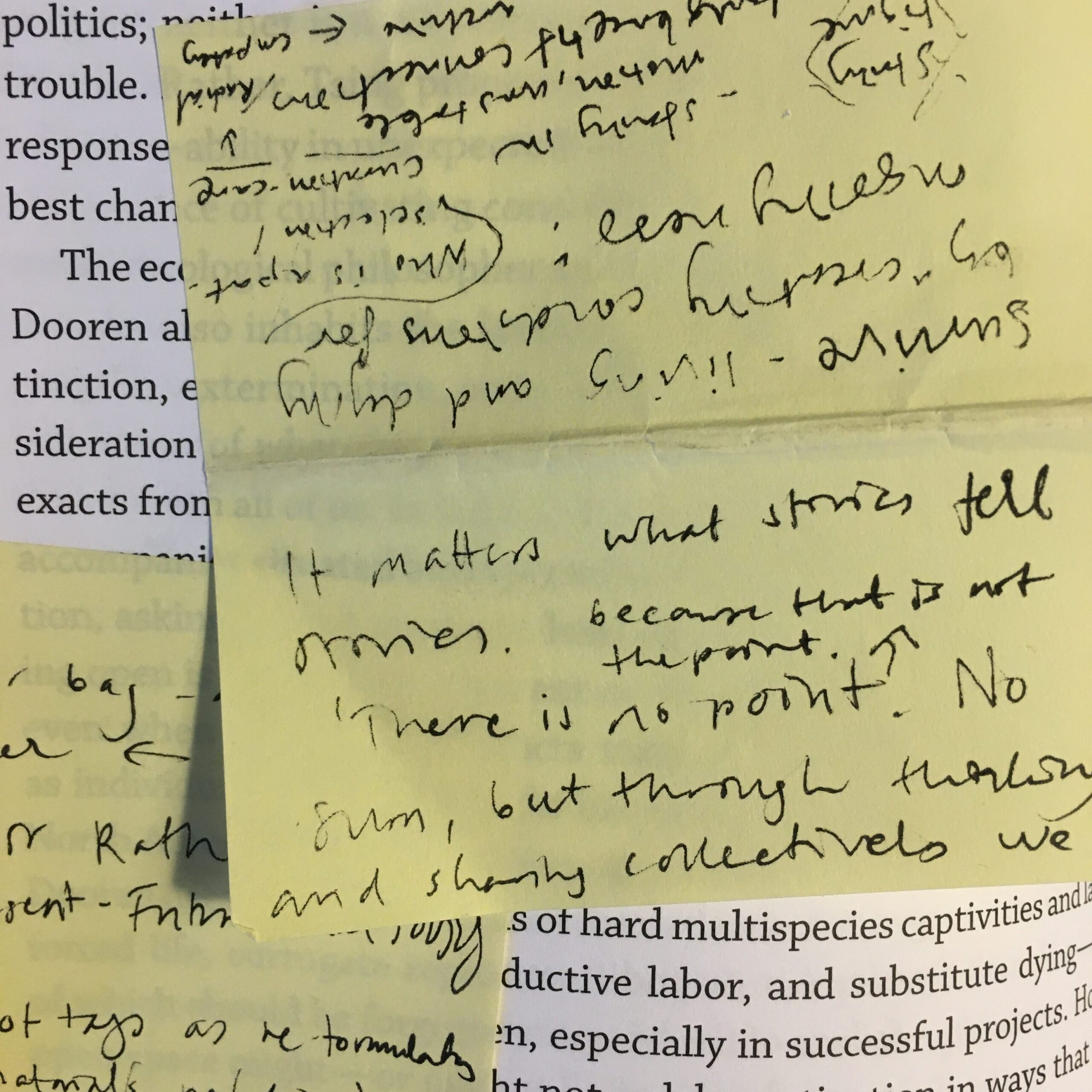
#car(ry)ing
Diving down in the 13 stories within the tag #car(ry)ing; I time travel to Ballet-ing: a repertory workshop with Ellen Söderhult and my calves remember jumping high and being a part of a flock. Ann Crosset talks about her work to involve children as makers at the Royal Ballet, and I recall her asking me what to do with all the documentation she saves on her attic. Through the story Sensitive Superpowers I am confronted with my own commitment to the field and how being a mother keeps affecting this relationship. The clarity of Sara Hamming’s workshop proposal gives me new directions. I re-experience the treasures and troubles of the 2018 events, through the words of Moa Sahlin.
Shapes and textures
Within #car(ry)ing I also meet Karis Zidore and Emilia Gasiorek through the story Containers of knowledge. Participating at the 2018 residency, the two dancers/choreographers had been invited to converse about the first edition of thecarrierbag festival, which they both were part of organizing one year earlier. Inspired partly by science-fiction writer Ursula K. Le Guin’s essay from 1989, The Carrier bag theory of fiction, they proposed the festival as a carrier bag – a place which gathers and holds its content, a container who has the ability to receive and to hug. In the story they reflect on the relationships between container and content, and at some point they arrive on the value of the way we are carrying knowledge.
I connect with their reflections, as we with Danish Dance Stories have worked on hosting encounters, which provides room for the participants to share and listen to each others experiences, thoughts and imaginations. I test out thinking of danskedansehistorier.dk as a carrier bag; as a container of stories, and this metaphor releases me from a more rigid idea of a classical archive organized through boxes on shelfs; the bag supports and even enhances messiness and lack of linearity – its content can move around, become somewhat shaken and come to touch other content. As the box, the bag is a holder, but with its soft, moldable contours it embraces what’s inside. A car(ry)ing bag.
What does then this Danish Dance Story-bag contain? All material gathered is an outcome of encounters and conversations, of dancing together and sharing practices. Some of the stories are recorded during the symposiums and the residency, some are revisited, re-membered and reconstructed. Some refer to the initiative itself; motivations, contextualizations of workshops, reflections and critique. Others are anecdotes, formulation of praxis, discussions on certain topics and what surrounds these. Somehow they all touch life with dance.
Touching content
I look into the pocket of #car(ry)ing and dwell with the double connection – caring, carrying. What stories do we carry? What stories do we care for? Carrying as a way of caring. Who cares for (Danish) dance, who is carrying it? I listen to colleagues, some I knew from before, some I never met. I hear them say things I never thought of, things I think about all the time and things that expand my horizons. I experience the stories differently, based on where I place myself for the occasion. The bag is what gathers me in, holds me, ensures that me and my colleagues are not scattered by the wind and that we can be found (again).
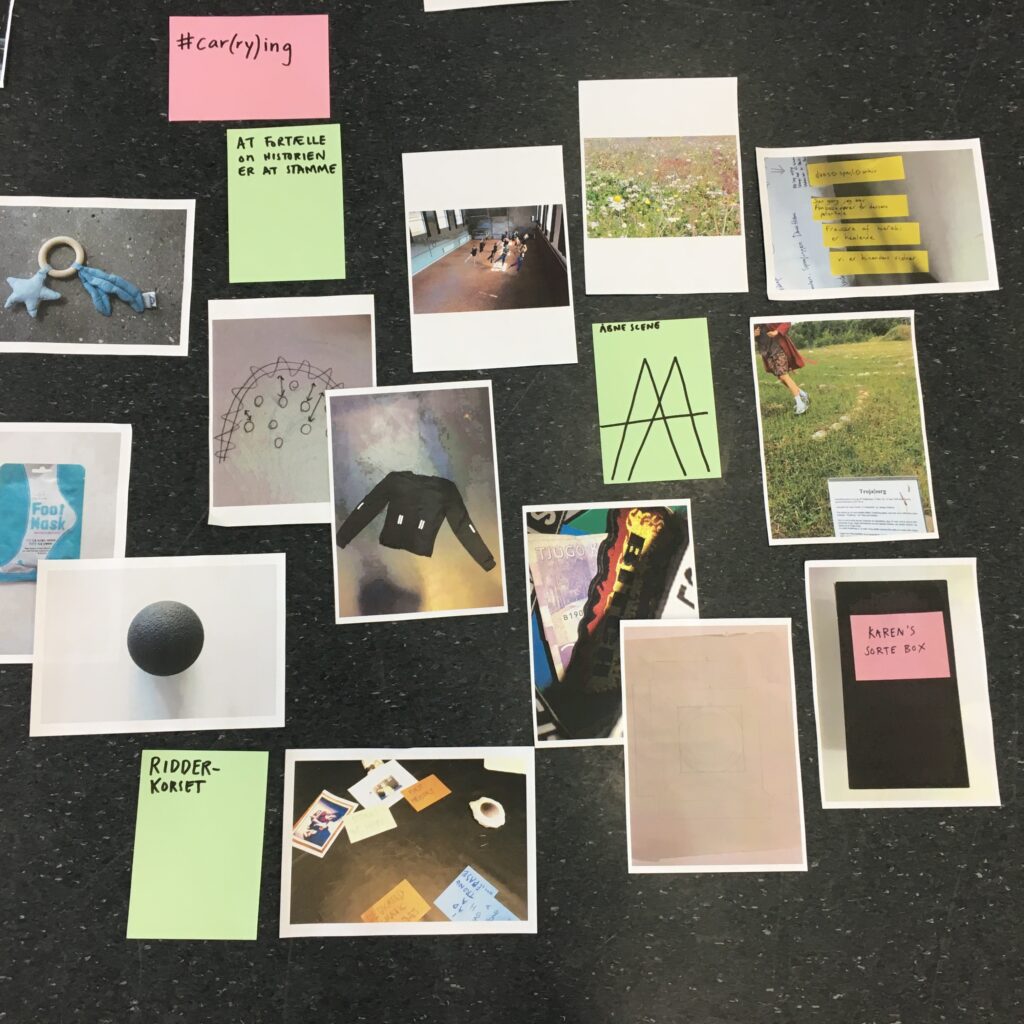
I often get lost in Danish Dance Stories’ carrier bag. Going astray and searching further before I might return. Googling Asta Mollerup and read that in the 1920s she started a dance school in Copenhagen, where students were co-creators of the performances and also were taught anatomy, language and cultural history. Watching a trailer about Kompagni B at det Kongelige, thinking about dance students in current times. I buy The carrier bag theory of fiction by Ursula K. Le Guin in a Danish translation and read it, sitting in the sun by the canal on Campus. The masks in the bag allow these excursions; weave the contents of the bag together with what is also outside.
As I am going further into the archive-bag, I am reminded of community, how dance always happens in relation. I use the site to become impressed by initiatives and reflections and moved by the struggles and forgiveness that have taken place in this community. I cry and I laugh. As I was attending the symposiums and the residency, voices, text fragments and images mix with my memory of past presence.
Lisa Nyberg also enhances a sensation of experiencing a community through the site. She suggests that if this is not an archive, it could be a collection of stories. A bag is designed for this purpose, for collecting. It feels right that it is a bag that encloses the content of the website. An archive without straight lines, because there are no straight lines in the world. No points either, I bring with me from Donna Haraway. Happenings, dreams, disappointments, conditions, humanity and trees – interwoven, carried and cared for, for a while.
History and hegemony
In her lecture within the story Dansehistoriernes Sorte Boks from 2018, Associate Professor Karen Vedel talks about the Danish Royal Theatre’s continuous and systematized journaling of events and materials. According to her, in addition to sustaining the repertoire, archiving serves to consolidate the institution’s hegemonic power. History is power and the archive is the key. Karen states that (my translation, at 12.15 in the clip): “The archive is the memory of the institution…Not everyone is privileged to have one.” Karen found a black box with clippings in the Royal Theater’s Archive. Materials that could have relevance to the history of dance in Denmark, but which did not fit in any of the institution’s categorizations. She brings a similar box of fragments of the past to the symposium and it is with these floaters we as participants at the symposium were invited to connect – with lives and dance outside the institution, outside official history.

Screenshot from the story ”Dansehistoriernes sorte boks” (https://danskedansehistorier.dk)
Karen’s contextualization makes me again doubt consolidating the term archive on the site. To care for the memory of the field, to write history, is by far a responsibility beyond our capacity. But by organizing and joining stories within the label danskedanshistorier.dk, we mime an archive and claim these stories to have value. Maybe the site could more clearly be presented as an invitation for a debate of what could constitute past, present and future dance? A place of re-membering? Somewhere to belong?
To provide more possibilities and to allow more options, Teresa Fogh Schou made a list of what the site is, if not/besides an archive. (My translation): ”A collage, a collective memory, a rhizomatic net/work, a manifesto, a call,a claimor an invitation to a political project, an artistic exploration, an artistic experience(?), an artwork in progress, a mouthpiece, a platform(?), a community, an entanglement of lives, a manifestation of us as part of history, a time travel, a time capsule, a waiting place(?), a personal database for dancers – is it the new Linked In?” I think all of them are valid.
Danish? Dance? Stories?
”It matters what thoughts think thoughts. It matters what knowledges know knowledge. It matters what relations relate relations. It matters what stories tell stories”
Donna Haraway, Staying with the Trouble p. 35
The story I agree with the question mark pokes and scratches as Lydia Östberg Diakité and Vibe Overgaard critically scrutinize the concepts of Danish, Dance and History. I am grateful that this story is a part of the archive; the way it touches, affects and reminds other stories, but especially because how it shakes the bag itself. ”The title provided for an umbrella that had to be negotiated again and again”, as Vibe formulates it in the story.
In the archive-bag I also recollect a text – DD Selv interview – where me, Stine, Andrea and Nanna engage with these concepts, attempting to unfold our motivation as initiators. The text contributes with more aspects to complex matters, but I dwell by the immanent negotiation of the title, hoping to come a bit further.
Danish. Dance. Stories. How come Danish is in the title? By framing the initiative in a Danish context, we as initiators wanted to situate the encounters, while attempting to curate a program which would substantiate the diversity and internationality, which we experience characterize dance in relation to Denmark. Also, the word carries an inherent criticality and thereby makes a discussion on inclusion and exclusion apparent. But as it sometimes feels that the connotations of the title brings more harm than healing, I’m recurrently in doubt of its eligibility.
The categorizations of Danish as well as of History traditionally keeps supporting hegemonic power, exclusion and norm. Lydia questions the (dis)agreement she felt of claiming to be a part of History, when applying to participate in the 2018 residency. As I listen to her, I sense this reflection to be crucial and complex. Our motivation as organizers was to create a possibility to meet, share and gather stories as a community across generations and in (playful) ways we also hoped to respond to (what we experienced as) a common feeling of lacking history. Did the participants sign up to being part of history? Is be(com)ing part of history voluntary? And if so, who provides that choice?
As I allow my self to dwell, I find the usage of the term history more and more confusing. Some direction is recovered as Vibe and Lydia refers to Paula Caspão’s workshop Danish dance (hi)stories – in small parts. Paula separates the term History – a powerful construction or systematization of cultural identity, and Historicity – the awareness of dealing with and looking upon history. I hope and trust that the different attempts of activation, have and will contribute to a critical, responsible and humble debate on what history is and how it matters. Because the negotiation needs to be there.
Pluralities
Stories < Historier. Adding plurality in the title is an attempt to rupture history’s officiality and by selecting Stories instead of Histories in the English translation, we as organizers hoped to enhance content above category. As a response to the inadequacy in the Danish language, some participants claimed the Danish word ”Storie” during the 2018 residency.
I experience through the tags and in the content how the site attends to splitting categories, finding new wordings and using them for alternative meaning-making. So, as with bending history in plural, how could the word ”Danish” become challenged? How can it become pluralized? Danishes? More-than-Danish? Doesn’t really work. Lydia suggests to change the title to ”local”, or to remove its reference to a nationality all together. Maybe this would be, if not a solution, a valid response to an issue. Dance stories < Dansehistorier. I sense how this title releases a lot of tension and makes it easier to spell out. But something happens to the friction within the other words. With Danish out, the connotation to History, which weight was enhanced by the national state, is weakened. By removing Danish, history is somehow also diminished, and as this happens I sense that some agency gets lost. Because I want to claim that personal stories – stories of illness, failure, motherhood and childhood – should have a part in history. Sometimes I am in doubt of the title, and then I become willing to risk that agency – but then again. Maybe this uncomfortable title should not be erased, but remain as fuel for future debates? dansehistorier.dk. I cannot say if the link will work in a near future…
Dances yet to be danced
Phyllis Akinyi points out to me that the amount of materials of the webpage has become quite voluminous and as there is no official archive of Danish dance history outside of the Royal Theater, which this counter archive can dispute, its gathering of stories do matter. It becomes a significant collection and as a sum it tells a story (of Danish Dance). With the expansion follows a responsibility, Phyllis reminds me. When I undergo the content of the bag, it is quite clear that a majority of the stories stems from western traditions and several are connected to institutions like the National School of Performing Arts. I start to believe that ’Dance’ is the pink elephant in the room. At least the constitution of what is included in the term ’Dance’ needs to be scrutinized further within and beyond Danish Dance Stories. There are for sure more stories to be told, more stories to be listened to.
Storytelling as a way of survival
Through reflecting on other and in between categorizations, as addressed in the story Blindspot Unfolded, I am re-approaching #future dance, without being clear of what direction(s) that leads there. My writing-process as my reasoning feels more ungraspable, blurrier as I steer in spirals to get somewhere (else). I return to browsing in Staying with the trouble, hoping to attach my blurriness on Haraway’s clarities. I rest my eyes on an image of an octopus (Haraway, 2016, p.57), and read about surrendering to the capacity of thinking through ”tentacular thinking,” as a possible necessity for planetarian survival. By thinking other stories, other entanglements and relations, composting, grieving and taking response-ability. (Haraway, 2016 p. 32-44)
By leaning on Haraway, I trust that simultaneous multeity might be a direction for the future. By thinking multiple thoughts, or by sharing multiple stories, the healing is collective. A weave is woven, for others to attach with. History writing is not an act of becoming immortal (that’s not the point, as there is no point) – instead I play with the thought that the practice of storytelling (and listening) is crucial in order to survive as a whole…
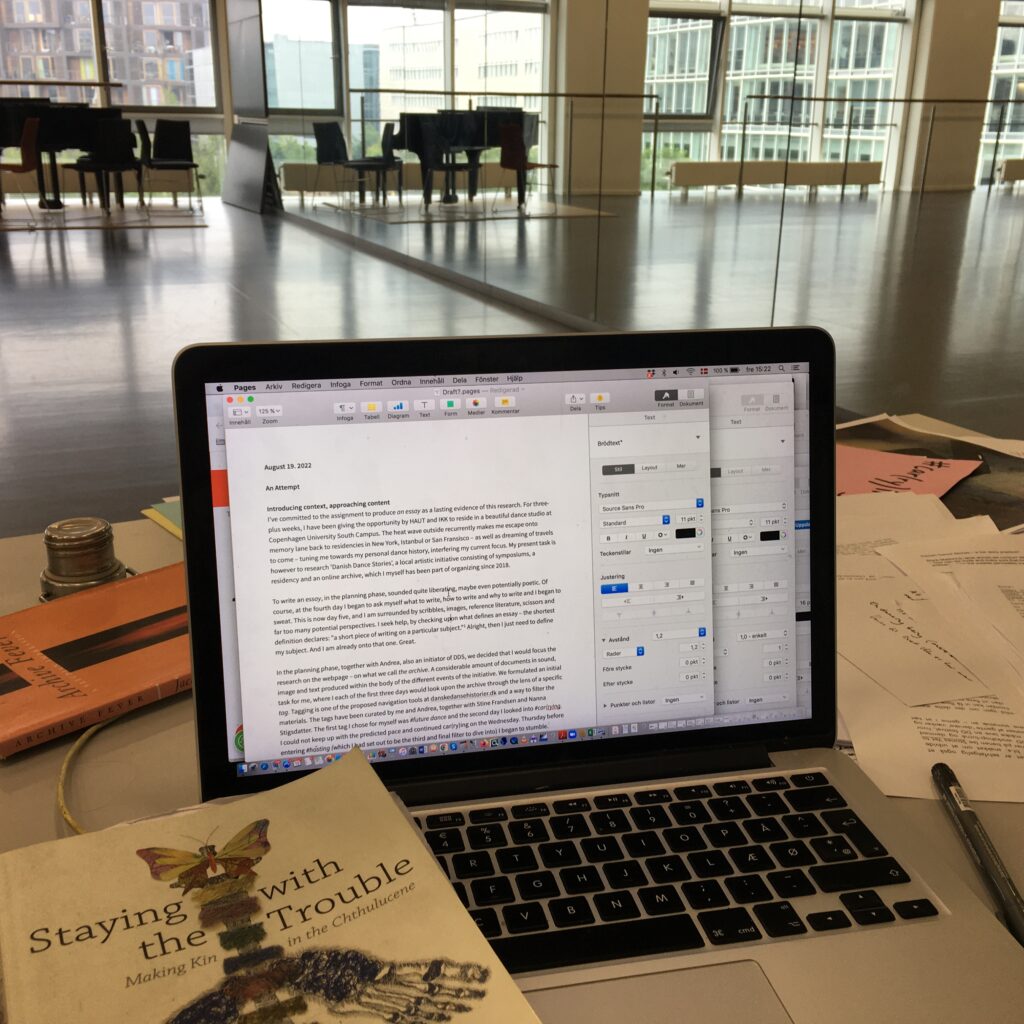
#future dance
”In the future we’ll be nostalgic about the times when Denmark was still held by gravity.”
From the story Imaginations unfolded
I am with dancing when Haraway writes about Tentacular Thinking. To multiply attention, to think together, think simultaneously, relates for me with dancing. More than forty years ago, dancer and philosopher Maxine Sheets-Johnstone wrote the article ”Thinking in Movement” in The Journal of Aesthetics and Art Criticism, Vol. 39, No. 4, 1981 about dance improvisation, about different kinds of thinking and of the distinctions between thinking and words. She writes about dancing-thinking: ”the very ground of this nonseparation [thinking and doing] is the capacity, indeed, the very experience of the dancer, to be thinking in movement. ” (Sheets-Johnstone, 1983, p.400) Some pages later she continues: ”Yet ”thinking in movement” is an apt descriptive rendering of a way of being in the world, a way which can be clarified and elaborated further.”(Sheets-Johnstone, 1983, p.404) I think the world (and the words) needs thinking in movement and that we as dancers should acknowledge this knowledge and work on further elaborations.

Towards multiplicity
The stories of danskedansehistorier.dk spring from being(s) with the experience of thinking in movement. As such, I sense how dancing-thinking exists in the cracks between words, how this experience brings proposals, ambitions, dreams and perspectives for worlds to come. By weaving these stories I experience how past and future dance(r)s becomes connected, how perspectives gives me hope. I connect with the word permanentia from Lucia Jaén Serrano, and how Taneli Törmä proposes kids as teachers. Karin Bergman reminds me of the cool thing of allowing oneself to be affected and Helene Cecilie Mørk of living through limitations. Birgitte Skands presents herself a dancing being… For me, stories like these steers in spirals towards a future to come.
I zoom in on some of the wordings formulated at the workshop Øjeblikket af en bevægelse udfoldet, and I (want to) believe that dancing-thinking provides opportunities to rupture categorization and to allow for more in-betweens and other entanglements. Future formulations from a past presence, from remembering in movement:
Blossom ears
dimensions of pink
The panther-woman was born inside a tree.
I touched it and it started to remember me
we are rocks and trees, waves and materials we do not yet have discovered.
Arriving, again
Sara Hamming suggests something quite untranslatable, through the title of her workshop at the 2018 residency: At fortælle om historien er at stamme. ”At stamme” means to stutter, but in Danish it is also the word for a tribe, as well as a trunk of a tree. Attempting translation: To (re)tell the (hi)story is to stutter. Or maybe: To tell about the hi/story is to stutter. Repetition as a mode of telling stories. To tell stories is to practice a tribe. History is to stem from somewhere. To hesitate. To risk being patronized and to insist being listened to. History is to be connected with ones roots. As her title continues to unfold between her and the participants’ (re)formulations and my own associations, I come to think of Donna Haraway’s expression of ’making kin’. I find a quote in an online article, where she states: ”By kin I mean those who have an enduring mutual, obligatory, non-optional, you-can’t-just-cast-that-away-when-it-gets-inconvenient, enduring relatedness that carries consequences”(Paulson, 2019). Practicing the tribe. Making kin. Enduring relatedness. Connected through practice.
I let Sara’s proposal provide me with an exit through its multiplicity and entanglement. An exit out of this text, out of this re-search and (back) into a community. I do feel that I have arrived somewhere. Not at a point, but many places; in the cracks, the in-betweens, the entanglements, in the past, the future, the present…
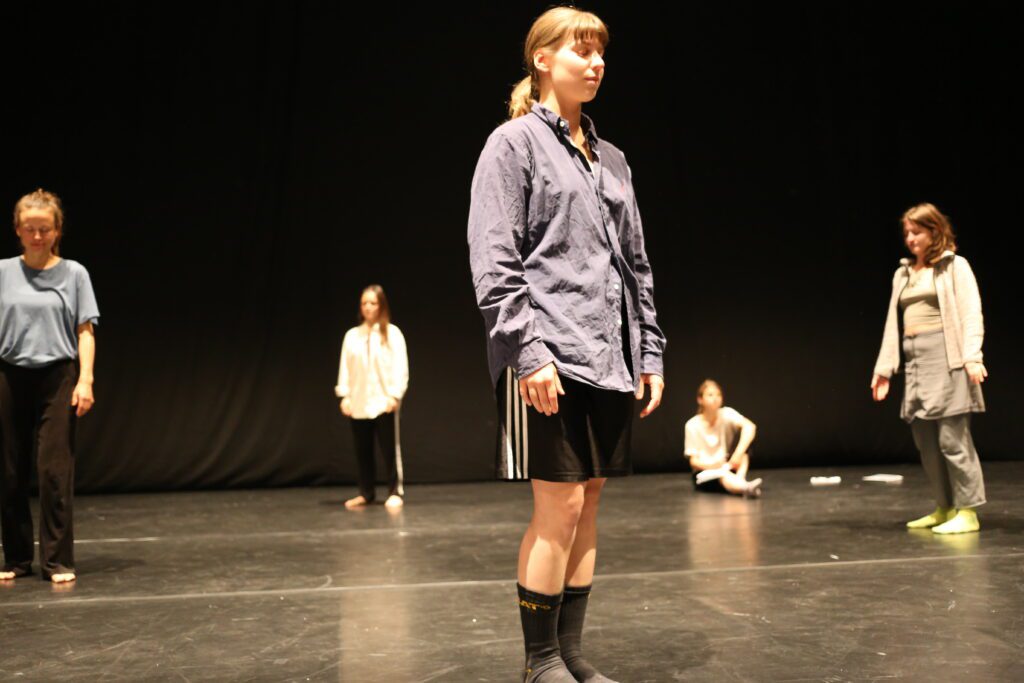
Thank you HAUT and Karen Vedel for providing the opportunity and practical frames for this process. Thank you Phyllis Akinyi, Teresa Fogh Schou, Mette Garfield and Lisa Nyberg for contributing with your knowledge and perspectives. THANK YOU Andrea Deres and Stine Frandsen for being there, supporting and questioning together with me during the residency. And thank you Nanna Stigsdatter and ALL which have been part of Danish Dance Stories 2018 and Stories yet to be told 2021.
